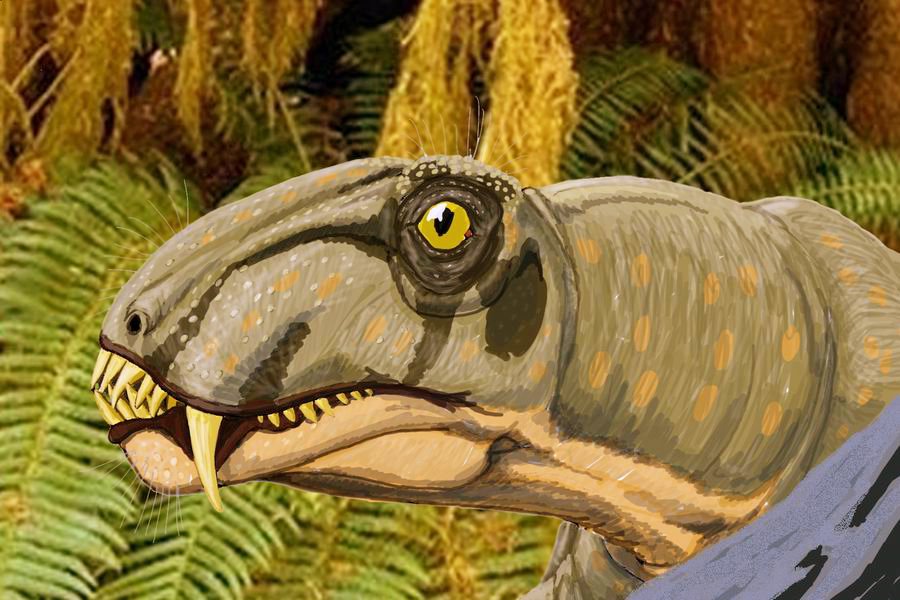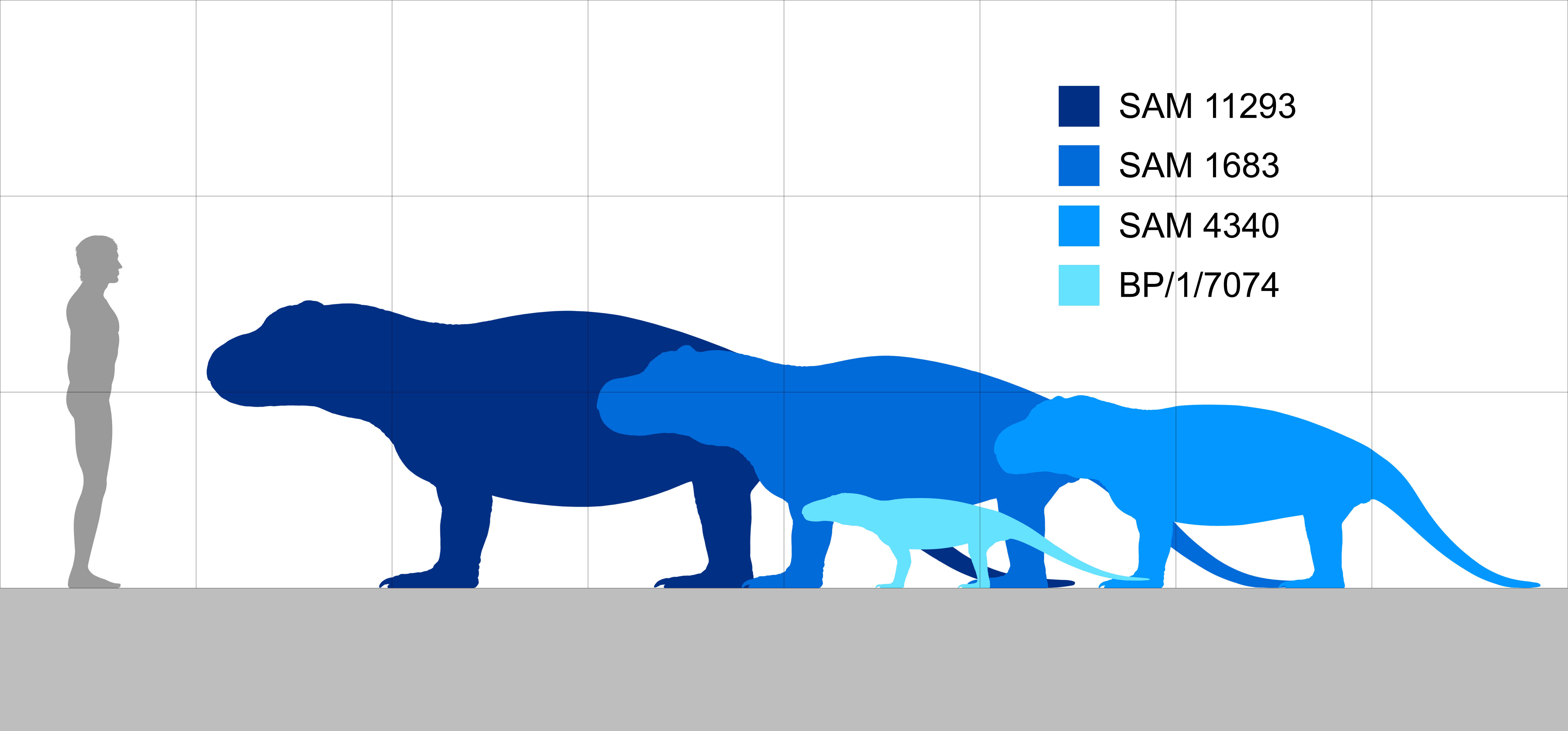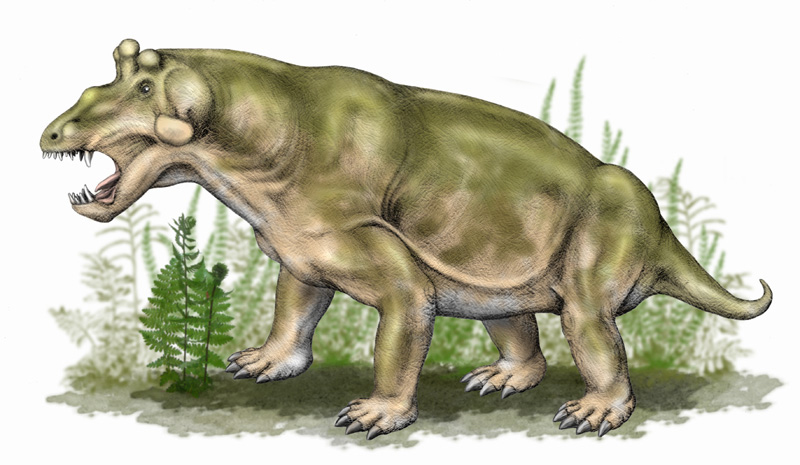|
Australosyodon
''Australosyodon'' is an extinct genus of dinocephalian therapsids from the middle Permian of South Africa. The first fossil was discovered in the 1980s near the village of Prince Albert Road in the Karoo region of South Africa. The genus is closely related to the genus ''Syodon'', found in the Russian Ischejewo fauna, and is thus regarded as the earliest example of an anteosaurid Dinocephalia outside of Russia. ''Australosyodon'' fossils have been recovered from the Eodicynodon Assemblage Zone, the lowest bank of the South African Beaufort Group, indicating the presence of primitive early therapsids in the southern hemisphere. The genus was first described by Bruce S. Rubidge in 1994. Description ''Australosyodon'' was a medium-sized dinocephalian. The skull was high and narrow, with a length of 26 cm, indicating a total body length of approximately 1.8 m (6 ft). The top of the skull displayed the thickening typical of dinocephalians. Overall there are many ... [...More Info...] [...Related Items...] OR: [Wikipedia] [Google] [Baidu] |
Sinophoneus Yumenensis
''Sinophoneus'' is an extinct genus of carnivorous dinocephalian therapsid belonging to the family Anteosauridae. It lived 272 to 270 million years ago at the beginning of the Middle Permian (Lower Roadian) in what is now the Gansu Province in northern China. It is known by a skull of an adult individual (the holotype GMV1601), as well as by many skulls of juvenile specimens. The latter were first considered as belonging to a different animal, named ''Stenocybus'', before being reinterpreted as immature ''Sinophoneus''. ''Sinophoneus'' shows a combination of characters present in other anteosaurs. Its bulbous profile snout and external nostrils located in front of the canine are reminiscent of the basal anteosaur ''Archaeosyodon'', while its massive transerse pterygoids processes with enlarged distal ends are more similar to the more derived anteosaurs ''Anteosaurus'' and ''Titanophoneus''. First phylogenetic analyzes identified ''Sinophoneus'' as the most basal Anteosaurinae. A ... [...More Info...] [...Related Items...] OR: [Wikipedia] [Google] [Baidu] |
Anteosaurus
''Anteosaurus'' (meaning "Antaeus reptile") is an extinct genus of large carnivorous dinocephalian synapsid. It lived at the end of the Guadalupian (= Middle Permian) during the Capitanian stage, about 265 to 260 million years ago in what is now South Africa. It is mainly known by cranial remains and few postcranial bones. With its skull reaching in length and a body size estimated at more than in length, and in weight, ''Anteosaurus'' was the largest known carnivorous non-mammalian synapsid and the largest terrestrial predator of the Permian period. Occupying the top of the food chain in the Middle Permian, its skull, jaws and teeth show adaptations to capture large prey like the giants titanosuchids and tapinocephalids dinocephalians and large pareiasaurs. As in many other dinocephalians the cranial bones of ''Anteosaurus'' are pachyostosed, but to a lesser extent than in tapinocephalid dinocephalians. In ''Anteosaurus'', pachyostosis mainly occurs in the form of horn-sha ... [...More Info...] [...Related Items...] OR: [Wikipedia] [Google] [Baidu] |
Syodontinae
Syodontinae is a group of dinocephalian therapsids. It is one of two subfamilies in the family Anteosauridae, the other being Anteosaurinae. They are known from the Middle Permian Period of what is now Russia and South Africa. One of the best known syodontines is ''Syodon'' from Russia. The South African form ''Australosyodon'', is one of the earliest known Gondwanan anteosaurs. Description Syodontines lack the boss on the lower jaw that characterises the related anteosaurines, and they have often been considered more primitive in this respect. Classification Below is a cladogram showing syodontine relationships from a 2012 phylogenetic In biology, phylogenetics (; from Greek φυλή/ φῦλον [] "tribe, clan, race", and wikt:γενετικός, γενετικός [] "origin, source, birth") is the study of the evolutionary history and relationships among or within groups o ... study of anteosaurians: References Anteosaurs Guadalupian first appearances Guada ... [...More Info...] [...Related Items...] OR: [Wikipedia] [Google] [Baidu] |
Eodicynodon Assemblage Zone
The ''Eodicynodon'' Assemblage Zone is a tetrapod assemblage zone or biozone which correlates to the Abrahamskraal Formation, Adelaide Subgroup of the Beaufort Group, a fossiliferous and geologically important geological Group of the Karoo Supergroup in South Africa. The thickest outcrops, reaching approximately , occur south-east of Sutherland, north of Prince Albert, and south-east of Beaufort West. The ''Eodicynodon'' Assemblage Zone is the lowermost biozone of the Beaufort Group. The name of the biozone refers to '' Eodicynodon oosthuizeni'', a small to medium-sized herbivorous dicynodont therapsid. It is characterized by the presence of this dicynodont species along with the subspecies '' Eodicynodon oelofseni'', and the dinocephalian '' Tapinocaninus pamelae''. History The first fossils to be found in the Beaufort Group rocks that encompass the current eight biozones were discovered by Andrew Geddes Bain in 1856. However, it was not until 1892 that it was observed that ... [...More Info...] [...Related Items...] OR: [Wikipedia] [Google] [Baidu] |
Anteosaurinae
Anteosaurinae is an extinct subfamily of dinocephalian therapsids. It is one of two subfamilies in the family Anteosauridae, the other being Syodontinae. Description These are very specialized, very large anteosaurs. The postcanine teeth are further reduced. Deepening of the postorbital region of the skull (behind the eyes) produced a larger temporal opening, indicating more muscle mass. The boss on the angular (rear of the jaw) has become very prominent, again, another sign of powerful jaw muscles. These huge animals were clearly formidable predators. In the Anteosaurinae, pachyostosis is taken to extremes. The dorsal (upper) surface of the nasal, frontal, and postfrontals (around and between/above the eyes) is thickened and rugose in the same manner as the tapinocephalids. Nevertheless these animals are too specialized and too late in time to have been the ancestors of the herbivorous tapinocephalids, so these characteristics evolved independently. Boonstra notes that the h ... [...More Info...] [...Related Items...] OR: [Wikipedia] [Google] [Baidu] |
Anteosauridae
Anteosauridae is an extinct family of large carnivorous dinocephalian therapsids that are known from the Middle Permian of Asia, Africa, and South America.These animals were by far the largest predators of the Permian period, with skulls reaching 80 cm in length in adult individuals, far larger than the biggest gorgonopsian. Description Anteosaurids are characterized by very large pointed incisors and canines, bulbous spatulate (spoon shaped) postcanines, a very strongly upturned margin of the premaxilla, so the front of mouth curves strongly upwards, and a long, very robust lower jaw (Boonstra 1963). Anteosaurids distinguished from ''Brithopus'' and other non-anteosaurid anteosaurians by the presence of a large thickened region or "boss" on the side of the angle of the lower jaw; this was probably used in intraspecific behaviour. In '' Doliosauriscus'' and ''Anteosaurus'', not only was this boss very prominent, but the bones were very thick and rugose. The same situation ... [...More Info...] [...Related Items...] OR: [Wikipedia] [Google] [Baidu] |
Anteosauridae
Anteosauridae is an extinct family of large carnivorous dinocephalian therapsids that are known from the Middle Permian of Asia, Africa, and South America.These animals were by far the largest predators of the Permian period, with skulls reaching 80 cm in length in adult individuals, far larger than the biggest gorgonopsian. Description Anteosaurids are characterized by very large pointed incisors and canines, bulbous spatulate (spoon shaped) postcanines, a very strongly upturned margin of the premaxilla, so the front of mouth curves strongly upwards, and a long, very robust lower jaw (Boonstra 1963). Anteosaurids distinguished from ''Brithopus'' and other non-anteosaurid anteosaurians by the presence of a large thickened region or "boss" on the side of the angle of the lower jaw; this was probably used in intraspecific behaviour. In '' Doliosauriscus'' and ''Anteosaurus'', not only was this boss very prominent, but the bones were very thick and rugose. The same situation ... [...More Info...] [...Related Items...] OR: [Wikipedia] [Google] [Baidu] |
Cladistics
Cladistics (; ) is an approach to biological classification in which organisms are categorized in groups (" clades") based on hypotheses of most recent common ancestry. The evidence for hypothesized relationships is typically shared derived characteristics ( synapomorphies'')'' that are not present in more distant groups and ancestors. However, from an empirical perspective, common ancestors are inferences based on a cladistic hypothesis of relationships of taxa whose character states can be observed. Theoretically, a last common ancestor and all its descendants constitute a (minimal) clade. Importantly, all descendants stay in their overarching ancestral clade. For example, if the terms ''worms'' or ''fishes'' were used within a ''strict'' cladistic framework, these terms would include humans. Many of these terms are normally used paraphyletically, outside of cladistics, e.g. as a 'grade', which are fruitless to precisely delineate, especially when including extinct species. R ... [...More Info...] [...Related Items...] OR: [Wikipedia] [Google] [Baidu] |
Archaeosyodon Praeventor
''Archaeosyodon'' is an extinct genus of dinocephalian therapsids. It was medium-sized, reaching about 1.5–2 m (4–5 ft) in length. See also * List of therapsids This list of therapsids is an attempt to create a comprehensive listing of all genera that have ever been included in the Therapsida excluding mammals and purely vernacular terms. The list includes all commonly accepted genera, but also genera tha ... References Anteosaurs Prehistoric therapsid genera Permian synapsids of Asia Prehistoric synapsids of Europe Guadalupian synapsids Fossil taxa described in 1960 Guadalupian genus first appearances Guadalupian genus extinctions {{paleo-therapsid-stub ... [...More Info...] [...Related Items...] OR: [Wikipedia] [Google] [Baidu] |
Tapinocaninus Pamelae
''Tapinocaninus'' is an extinct genus of therapsids in the family Tapinocephalidae, of which it is the most basal member. Only one species is known, ''Tapinocaninus pamelae'' (meaning "Pam's humble canine"). Fossils have been found dating from the Middle Permian (Wordian age). Description This species is known from several skulls. It was a large animal, reaching up to in body mass. It is assumed to be either a herbivore or an omnivore. This dinocephalian has a heterodont dentition, consisting of incisors, canines and postcanines. Its canine teeth lack a definite crushing heel. The maxillary and premaxillary dentition is only partially preserved. The species is named in honour of Rubidge's mother. Discovery Fossils have been found in the Eodicynodon Assemblage Zone The ''Eodicynodon'' Assemblage Zone is a tetrapod assemblage zone or biozone which correlates to the Abrahamskraal Formation, Adelaide Subgroup of the Beaufort Group, a fossiliferous and geologically important geo ... [...More Info...] [...Related Items...] OR: [Wikipedia] [Google] [Baidu] |
Ulemosaurus Svijagensis
''Ulemosaurus'' is an extinct genus of dinocephalian therapsids that lived 265 to 260 million years ago, at Isheevo in Russian Tatarstan. It was a tapinocephalid, a group of bulky herbivores which flourished in the Middle Permian. ''Ulemosaurus'' and other tapinocephalians disappeared at the end of the Middle Permian. Description Only several partial skeletons and skulls have been found. The skull bones are extremely dense: about at its thickest. This thickening is possibly related to head-butting behavior, as some researchers suggest. The species is considered a herbivore, but because the mandible is heavily constructed some palaeontologists consider it a carnivore, with the species being able to use muscle power to cut prey up with its incisors. Classification ''Ulemosaurus'' is a large ''Moschops''-like form from Russia; it is probably similar enough to be included as a separate species of ''Moschops''. Despite its advanced characteristics, it lived slightly before the Karoo ... [...More Info...] [...Related Items...] OR: [Wikipedia] [Google] [Baidu] |
Estemmenosuchus Uralensis
''Estemmenosuchus'' (meaning "crowned crocodile" in Greek) is an extinct genus of large, early omnivorous therapsid. It is believed and interpreted to have lived during the middle part of the Middle Permian around 267 million years ago. The two species, ''E. uralensis'' and ''E. mirabilis'', are characterised by distinctive horn-like structures, which were probably used for intra-specific display. Both species of ''Estemmenosuchus'' are from the Perm (or Cis-Urals) region of Russia. Two other estemmenosuchids, ''Anoplosuchus'' and ''Zopherosuchus'', are now considered females of the species ''E. uralensis''. There were many complete and incomplete skeletons found together. Description ''Estemmenosuchus'' could reach a body length of more than . Its skull was long and massive, up to in length, and possessed several sets of large horns, somewhat similar to the antlers of a moose, growing upward and outward from the sides and top of the head. The animal had a sprawling posture as ... [...More Info...] [...Related Items...] OR: [Wikipedia] [Google] [Baidu] |






